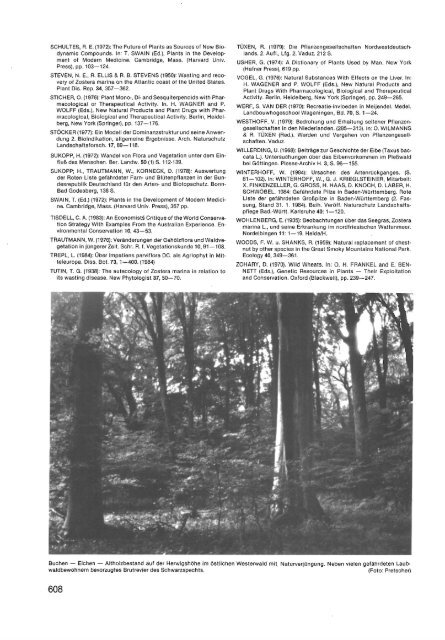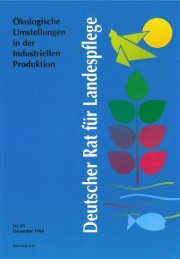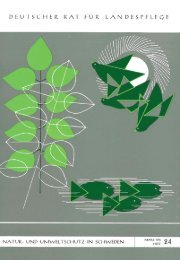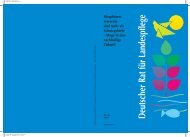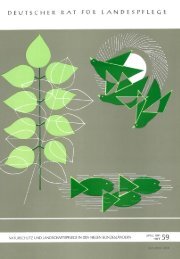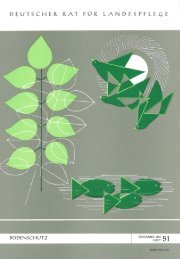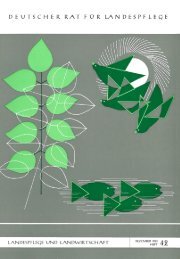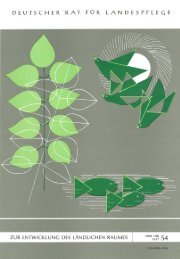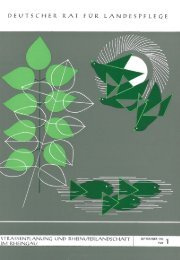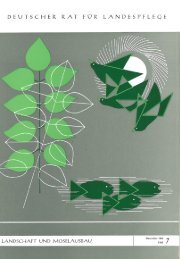Warum Artenschutz? - Deutscher Rat für Landespflege
Warum Artenschutz? - Deutscher Rat für Landespflege
Warum Artenschutz? - Deutscher Rat für Landespflege
Erfolgreiche ePaper selbst erstellen
Machen Sie aus Ihren PDF Publikationen ein blätterbares Flipbook mit unserer einzigartigen Google optimierten e-Paper Software.
SCHULTES, R. E. (1972): The Future of Plants as Sources of New Biodynamic<br />
Compounds. In: T. SWAIN (Ed.), Plants in the Development<br />
of Modern Medicine. Cambridge, Mass. (Harvard Univ.<br />
Press), pp. 103-124.<br />
STEVEN, N. E., R. ELLIS & R. B. STEVENS (1950): Wasting and recovery<br />
of Zostera marina on the Atlantic coast of the United States.<br />
Plant Dis. Rep. 34, 357 -362.<br />
STICH ER, 0 . (1976): Plant Mono-, Di-and Sesquiterpenoids with Pharrnacological<br />
or Therapeutical Activity. In. H. WAGNER and P.<br />
WOLFF (Eds.), New Natural Products and Plant Drugs with Pharmacologlcal,<br />
Biological and Therapeutical Activity. Berlin, Heidelberg,<br />
New York (Springer), PP- 137- 176.<br />
STÖCKER (1977): Ein Modell der Dominanzstruktur und seine Anwendung<br />
2. Bioindikation, allgemeine Ergebnisse. Arch. Naturschutz<br />
Landschaftsforsch. 17, 89-118.<br />
SUKOPP, H. (1972): Wandel von Flora und Vegetation unter dem Einfluß<br />
des Menschen. Ber. Landw. 50 (1) S. 112-139.<br />
SUKOPP; H., TRAUTMANN, W., KORNECK, D. (1978): Auswertung<br />
der Roten Liste gefährdeter Farn- und Blütenpflanzen in der Bundesrepublik<br />
Deutschland für den Arten- und Biotopschutz. Bonn<br />
Bad Godesberg, 138 S.<br />
SWAIN, T. (Ed.) (1972): Plants in the Development of Modern Medicine.<br />
Cambridge, Mass. (Harvard Univ. Press), 367 pp.<br />
TISDELL, C. A. (1983): An Economists Critique of the World Conservation<br />
Strategy With Examples From the Australian Experience. Environmental<br />
Conservation 10, 43- 53.<br />
TRAUTMANN, W. (1976): Veränderungen der Gehölzflora und Waldvegetation<br />
in jüngerer Zeit. Sehr. R. f. Vegetationskunde 10, 91-108.<br />
TREPL, L. (1984): Über lmpatiens parviflora DC. als Agriophyt in Mit·<br />
teleuropa. Diss. Bot. 73, 1-400. (1984)<br />
TUTIN, T. G. (1938): The autecology of Zostera marina in relation to<br />
its wasting disease. New Phytologist 37, 50- 70.<br />
TÜXEN , R. (1979): Die Pflanzengesellschaf ten Nordwestdeutsch·<br />
lands. 2. Aufl., Lfg. 2. Vaduz. 212 S.<br />
USHER, G. (1974): A Dictionary of Plants Used by Man. New York<br />
(Hafner Press), 619 pp.<br />
VOGEL, G. (1976): Natural Substances With Effects on the Liver. In:<br />
H. WAGENER and P. WOLFF (Eds.), New Natural Products and<br />
Plant Drugs With Pharmacological, Biological and Therapeutical<br />
Activity. Berlin, Heidelberg, New York (Springer), pp. 249- 265.<br />
WERF, S. VAN DER (1970): Recreatie-invloeden in Meijendel. Medel.<br />
Landbouwhogeschool Wageningen, Bd. 70, S. 1-24.<br />
WESTHOFF. V. (1979): Bedrohung und Erhaltung seltener Pflanzengesellschaften<br />
in den Niederlanden. (285- 313). In: 0. WILMANNS<br />
& R. TÜXEN (Red.). Werden und Vergehen von Pflanzengesellschaften.<br />
Vaduz.<br />
WILLERDING, U. (1968): Beiträge zur Geschichte der Eibe (Taxus baccata<br />
L.). Untersuchungen Ober das Eibenvorkommen im Pleßwald<br />
bei Göttingen. Plesse-Archiv H. 3, S. 96-155.<br />
WINTERHOFF, W. (1984): Ursachen des Artenrückganges. (S.<br />
81-102). In: WINTERHOFF, W., G. J. KRIEGLSTEINER, Mitarbeit:<br />
X. FINKENZELLER, G. GROSS, H. HAAS, D. KNOCH, D. LABER, H.<br />
SCHWÖBEL. 1984: Gefährdete Pilze in Baden-Wü rttemberg. Rote<br />
Liste der gefährdeten Großpilze in Baden-Württemberg (2. Fassung,<br />
Stand 31. 1. 1984). Beih. Veröff. Naturschutz Landschaftspflege<br />
Bad.-WOrtt. Karlsruhe 40: 1- 120.<br />
WOHLEN BERG, E. (1935): Beobachtungen über das Seegras, Zostera<br />
marina L., und seine Erkrankung im nordfriesischen Wattenmeer.<br />
Nordelbingen 11: 1-19. Heide/H.<br />
WOODS, F. w. u. SHANKS, R. (1959): Natural replacement of chestnut<br />
by other species In the Great Smoky Mountains National Park.<br />
Ecology 40, 349-361.<br />
ZOHARY, D. (1970). Wild Wheats. In: 0. H. FRANKEL and E. BEN·<br />
NETT (Eds.), Genetic Resources in Plants - Thelr Exploitation<br />
and Conservation. Oxford (Blackwell), pp. 239- 247.<br />
Buchen - Eichen - Altholzbestand äuf der Herwlgshöhe im östlichen Westerwald mit. Naturverjüngung. Neben vielen gefährdeten Laubwaldbewohnern<br />
bevorzugtes Brutrevier des Schwarzspechts.<br />
(Foto: Pretscher)<br />
608


